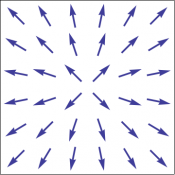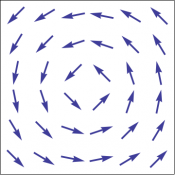You are here: start » book » mathcontent » vfields
Adapted basis vectors form a simple example of the geometric notion of a vector field, which is nothing more than a vector at each point. Each such vector should be thought of as “living” (having its tail at) the point at which it is defined, rather than at the origin.
An explicit example is provided by the polar basis vectors $\rhat$ and $\phat$, which are shown in Figure 3 of § {Wrap-Up: Curvilinear Basis Vectors}, and reproduced below.
Figure 1: The polar basis vector fields $\rhat$ and $\phat$, respectively.You can think of a vector field $\FF$ as a vector function, often written as any of $\FF(P)$, $\FF(\rr)$, $\FF(x,y,z)$, etc., that assigns a vector to each point $P$. Vector fields can be expanded with respect to any basis, so that we can write \begin{eqnarray*} \FF &=& F_x \,\xhat + F_y \,\yhat + F_z \,\zhat \qquad\hbox{(rectangular)} \\ &=& F_r \,\rhat + F_\phi \,\phat + F_z \,\zhat \qquad\hbox{(cylindrical)} \\ &=& F_r \,\rhat + F_\theta \,\that + F_\phi \,\phat \qquad\hbox{(spherical)} \\ \end{eqnarray*} where $F_x$ is called the component of $\FF$ with respect to $x$, or simply the $x$-component of $\FF$, and similarly for the other components. 1)

